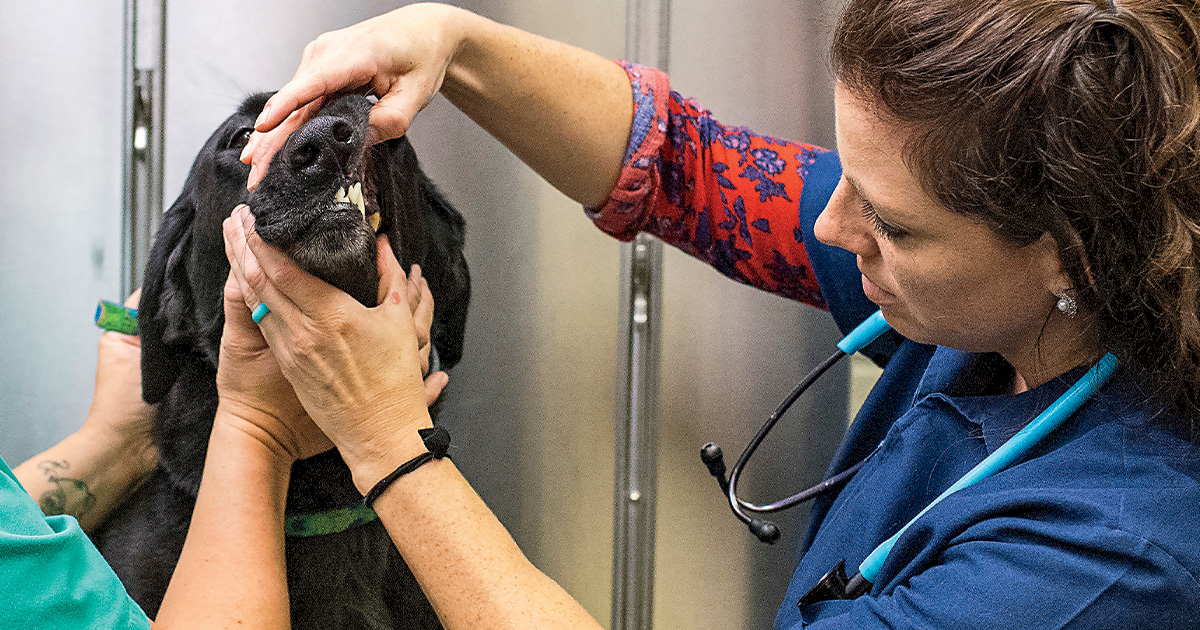Retrievers: Tending to Teeth
Untreated dental problems in dogs can sometimes lead to more serious health issues
Untreated dental problems in dogs can sometimes lead to more serious health issues


A hunting dog suffering from dental disease can’t perform at his best. He’s probably experiencing some pain, but that’s just the tip of the iceberg, says Dr. Jessie Waldvogel of the Animal Hospital of Ashwaubenon, Wisconsin. Noting that plaque, which is composed of bacteria, salivary proteins, and food particles, is the precursor to tartar, she explains, “As tartar builds up on the teeth, it eventually spreads into the gum line, causing inflammation and gingivitis. If left untreated, pockets form in the tissues, bacteria invade, the attachment weakens, and the teeth eventually fall out. These oral infections can become systemic if they’re not addressed, spreading to the kidneys, liver, heart, and even on rare occasions the brain. Older dogs are especially susceptible.”
The first sign that something’s not right, typically, is a change in your dog’s breath. “As plaque and tartar accumulate,” Waldvogel notes, “they begin to release sulfuric acid compounds, which produce that ‘rotten egg’ smell. Obviously, you shouldn’t expect your dog’s breath to smell minty-fresh, but if it smells noticeably bad it’s a sign that he needs to be examined by a veterinarian.”
The second thing owners tend to notice is the presence of blood. “You might see it in a dog’s water dish, on a chew toy, or even coming from the gums themselves,” Waldvogel continues. “Again, this is a clear sign that your dog is suffering from dental disease and needs to be evaluated by a vet.”
The usual recommendation in these instances is to schedule a complete dental cleaning, often referred to simply as a “dental.” While the specifics of the procedure vary depending on the severity of the clinical presentation, in general it involves removing plaque and tartar, on both the surface of the teeth and below the gum line. At the same time, the veterinarian will explore the entire oral cavity, check for other problems, and treat them accordingly.
All of this occurs while the animal is under anesthesia. “Having the dog under anesthesia allows us to take a good look at the entire mouth and find out what’s really going on in there, which is very hard to do when the dog’s awake,” Waldvogel notes. “Dogs don’t floss, and as a result you’re apt to find all sorts of things stuck in their teeth.”
Cost, which typically ranges between $500 and $1,000 for a dental without complications, can be another sticking point. “My response to that,” says Waldvogel, “is that having a dental done on a timely basis—meaning before problems develop—will save you money in the long run. If you let it go, and your dog requires oral surgery, you could easily end up paying twice what you would have paid for a ‘basic’ dental. And if you have that basic dental done, your dog might not need another one for three to five years.”
There are steps you can take to promote your dog’s dental health, the most effective of which is brushing his teeth. Your vet can show you how, and you need to do it at least twice a week to make a measurable difference. Use a toothpaste formulated specifically for dogs. Many of the toothpastes intended for humans contain an ingredient called xylitol, which can be fatal to dogs. Fluoride, which is found in most brands of toothpastes, is toxic to dogs as well.
Not every owner has the discipline needed to brush a dog’s teeth, and not every dog will tolerate the procedure. Over-the-counter chews can help delay the buildup of plaque and tartar—look for products approved by the Veterinary Oral Health Council—but they’re not a substitute for regular dental cleanings.
What about giving your dog beef marrow bones, pieces of deer antler, or similar hard, non-splintering items? Waldvogel admits that the teeth of dogs that routinely gnaw on these objects often look great. The trade-off is an increased incidence of tooth fractures.
This brings up one last, vitally important point. “The canine tooth is huge,” Waldvogel says. “The root extends deep into the nasal cavity. So if there’s decay, and pocketing, and infection, it’s going to negatively affect the sense of smell—and that’s huge for a hunting dog.”
Ducks Unlimited uses cookies to enhance your browsing experience, optimize site functionality, analyze traffic, and deliver personalized advertising through third parties. By continuing to use this site, you agree to our use of cookies. View Privacy Policy